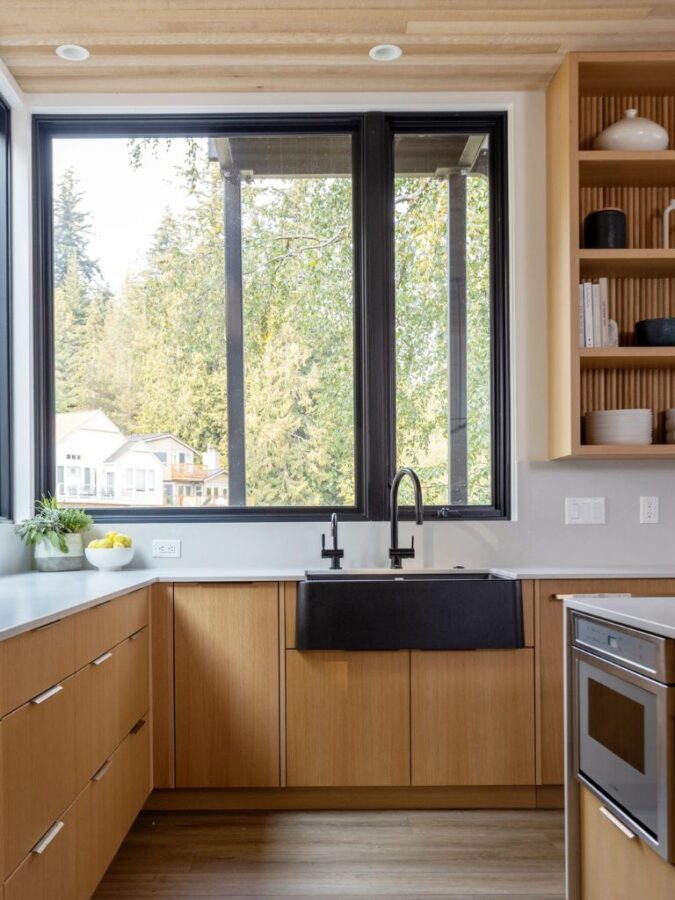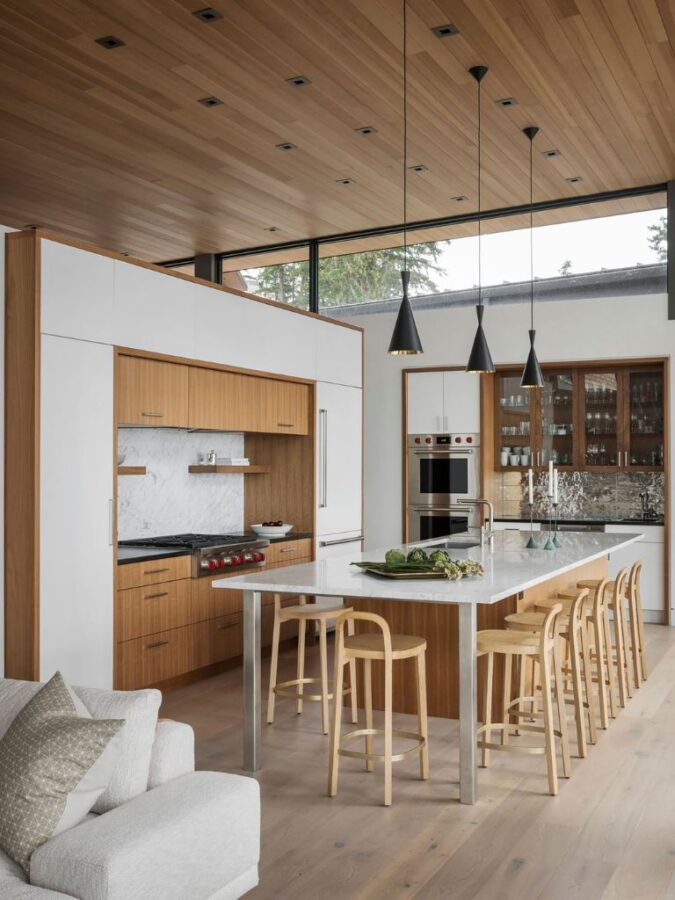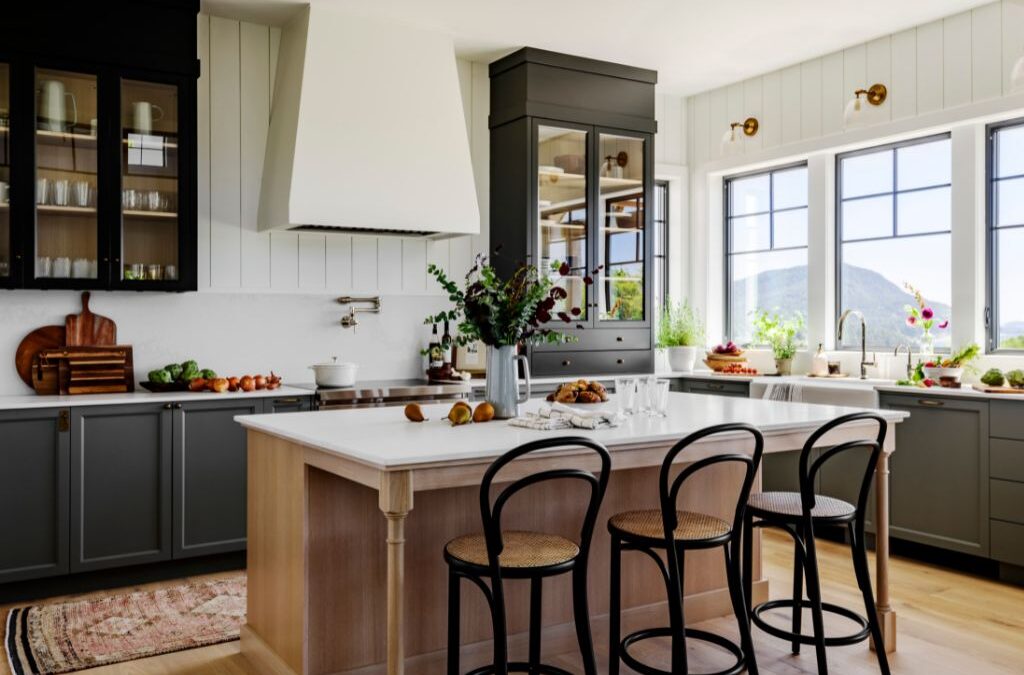When designing your dream kitchen, cabinetry plays a crucial role in shaping the space’s overall style and visual impact. Choosing a custom kitchen cabinet style often involves decisions about layout, finishes, and hardware. But have you considered the transformative potential of mixing different wood types in your cabinetry?
At Smith & Vallee Cabinet Makers, we’ve witnessed the creative potential of blending wood species. This approach not only results in functional cabinetry but also in truly beautiful and unique designs. It’s an opportunity for homeowners to express their creativity, enhance their home’s character, and bring their unique vision to life.
Here’s everything you need to know about effectively mixing wood types for custom cabinetry and how to ensure stunning, cohesive results.
The Beauty of Mixing Wood Types
Blending different wood types introduces depth, texture, and visual interest to your space. When cabinetry is uniform, it can sometimes create a flat appearance, especially in larger rooms or open-concept layouts. You break that monotony by thoughtfully combining wood species and creating a sophisticated, layered look.
For instance, pairing darker woods like walnut with lighter species such as maple or ash can create striking contrasts. Similarly, the warmth of cherry cabinetry can complement oak or hickory accents, highlighting the richness of each species. Incorporating mixed woods into custom kitchen cabinets provides visual variety without overwhelming the space.
People often ask us, “Can you mix different wood types in kitchen cabinets?” The answer is a clear yes, as long as you pay attention to a few key details. Successful combinations require intentional selection and thoughtful placement. Proper planning makes your cabinetry a harmonious design element, showcasing your personal style and adding significant value to your home.
Choosing Complementary Wood Species
Selecting complementary wood species is crucial for a cohesive design. It’s essential to consider color differences, grain patterns, textures, and natural wood tones. For instance, woods like oak, walnut, and maple have distinct grain patterns. Maple typically has a fine, subtle grain; walnut displays smoother grain with rich coloration, while oak is characterized by pronounced grain texture.
Combining woods with contrasting grains often creates compelling visual interest. For instance, pairing oak cabinetry doors with smooth walnut drawer fronts can provide a pleasing interplay of textures. Alternatively, mixing woods with similar grains but varying shades can create a subtle elegance. Think cherry and maple—two species with fine grains yet distinctly different color tones that complement each other beautifully.
At Smith & Vallee Cabinet Makers, we always recommend testing wood samples side by side before committing to your custom cabinets. Seeing the species together under your home’s lighting conditions helps ensure the combination aligns perfectly with your vision.

Balancing Colors and Finishes
Another common question homeowners have is, “Should wood finishes match exactly when mixing cabinetry wood types?” Actually, matching isn’t necessary—and often isn’t ideal. Using slightly varied finishes enhances visual depth, making your cabinetry appear thoughtfully designed rather than factory-produced.
However, balance is key. Too many conflicting finishes or shades can create visual chaos. A good rule of thumb is to select one dominant wood tone to anchor the cabinetry, then integrate secondary species or finishes as accents. For example, dominant cherry cabinets could be beautifully accented with maple drawer fronts stained in a complementary lighter shade.
Consider continuity throughout your home, too. Using consistent wood species in cabinetry helps create a cohesive flow, even when finishes differ slightly from room to room.
Incorporating Mixed Wood Cabinetry into Different Home Styles
Mixed wood cabinetry is remarkably versatile, seamlessly fitting into a variety of interior styles. Whether your space is classic, farmhouse-inspired, mid-century modern, or sleek and minimalist, mixed wood cabinetry can be designed to fit your unique vision.
Traditional kitchens benefit from mixing warm woods like cherry or mahogany with light-painted accents. A classic farmhouse style looks great with oak cabinetry paired with walnut or maple accents, adding rustic charm. Contemporary kitchens often embrace high-contrast wood combinations, such as sleek walnut cabinetry paired with light ash or painted wood accents.
Whatever your style, mixing wood cabinetry types allows you greater freedom to personalize your space. It adds authenticity, warmth, and timeless appeal—qualities standard cabinetry simply can’t deliver.
Practical Tips for Mixing Wood Types Effectively
While experimenting is encouraged, certain practical guidelines ensure successful outcomes when blending wood types:
- Limit your selection to two or three species: This prevents your cabinetry from appearing cluttered or chaotic.
- Keep the undertones consistent: Woods should share either warm or cool undertones to maintain visual harmony.
- Consider proportions carefully: Dominant woods should represent 60-70% of cabinetry, with accent woods comprising the remainder.
- Use transitional elements: Complementary hardware, countertops, or backsplash materials can bridge different wood types effectively.
Incorporating these principles will help you achieve cabinetry designs that look intentional, elegant, and cohesive.

Common Pitfalls to Avoid
While mixing woods is rewarding, certain missteps can negatively impact your cabinetry’s appearance. Avoid selecting woods with strongly clashing undertones—mixing cool gray-toned woods like ash with warm reddish woods such as mahogany, for example, can create dissonance.
Additionally, be cautious about mixing multiple bold, dramatic grain patterns, as they can compete visually. A safer approach is pairing one dramatic-grain wood with subtler, simpler-grain counterparts.
Maintaining Your Mixed Wood Cabinets
Maintenance of mixed wood cabinetry is straightforward and aligns with the care you’d give any high-quality cabinets. Preserving the beauty of your cabinets requires consistent dusting, prompt spill cleanup, and the careful use of non-abrasive cleaning solutions.
Beyond routine cleaning, the beauty of mixed wood cabinetry lies in its inherent visual interest. Combining various wood species creates contrasting grains and tones that introduce a unique, textured aesthetic to your kitchen or other living areas. This inherent variation can also be quite forgiving, subtly minimizing the appearance of minor wear and tear over time.
Create Your Dream Cabinets with Confidence
Mixing wood types offers endless opportunities to personalize your custom cabinetry, enhancing the warmth, beauty, and value of your home. By thoughtfully choosing complementary wood species and carefully balancing colors and finishes, you can create cabinetry that is not only beautiful but uniquely yours.
At Smith & Vallee Cabinet Makers, we pride ourselves on crafting high-quality custom cabinetry, bringing your design vision to life through expert craftsmanship and responsive service. With careful planning and expert guidance, your mixed wood cabinets can become the most admired feature of your home.
Ready to Transform Your Cabinets?
If you’re inspired to explore mixed wood cabinetry for your home, contact our team at Smith & Vallee Cabinet Makers. Our experienced craftspeople are ready to help you design custom cabinets that seamlessly blend beauty, functionality, and style. Reach out today and turn your cabinetry dreams into reality.

